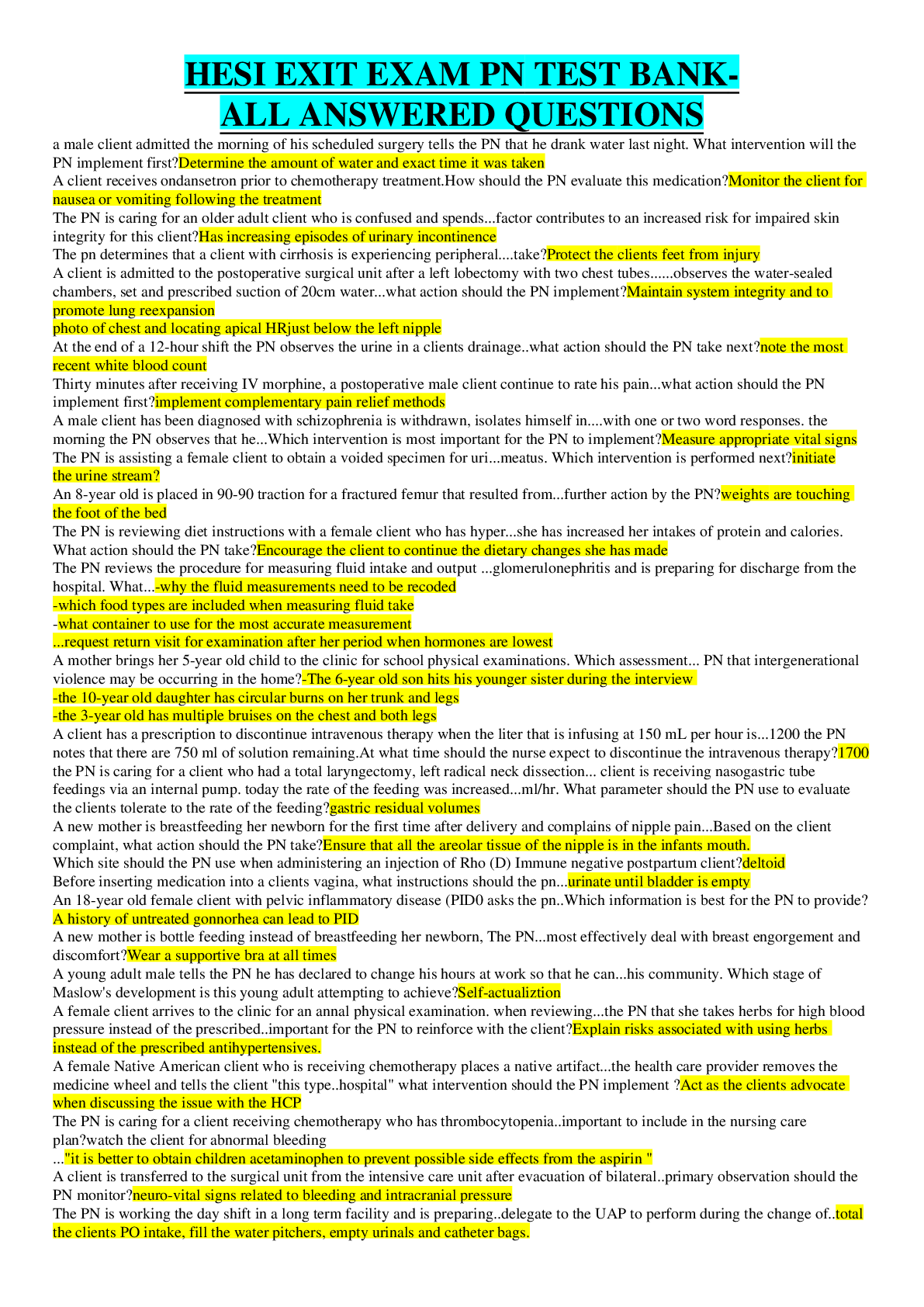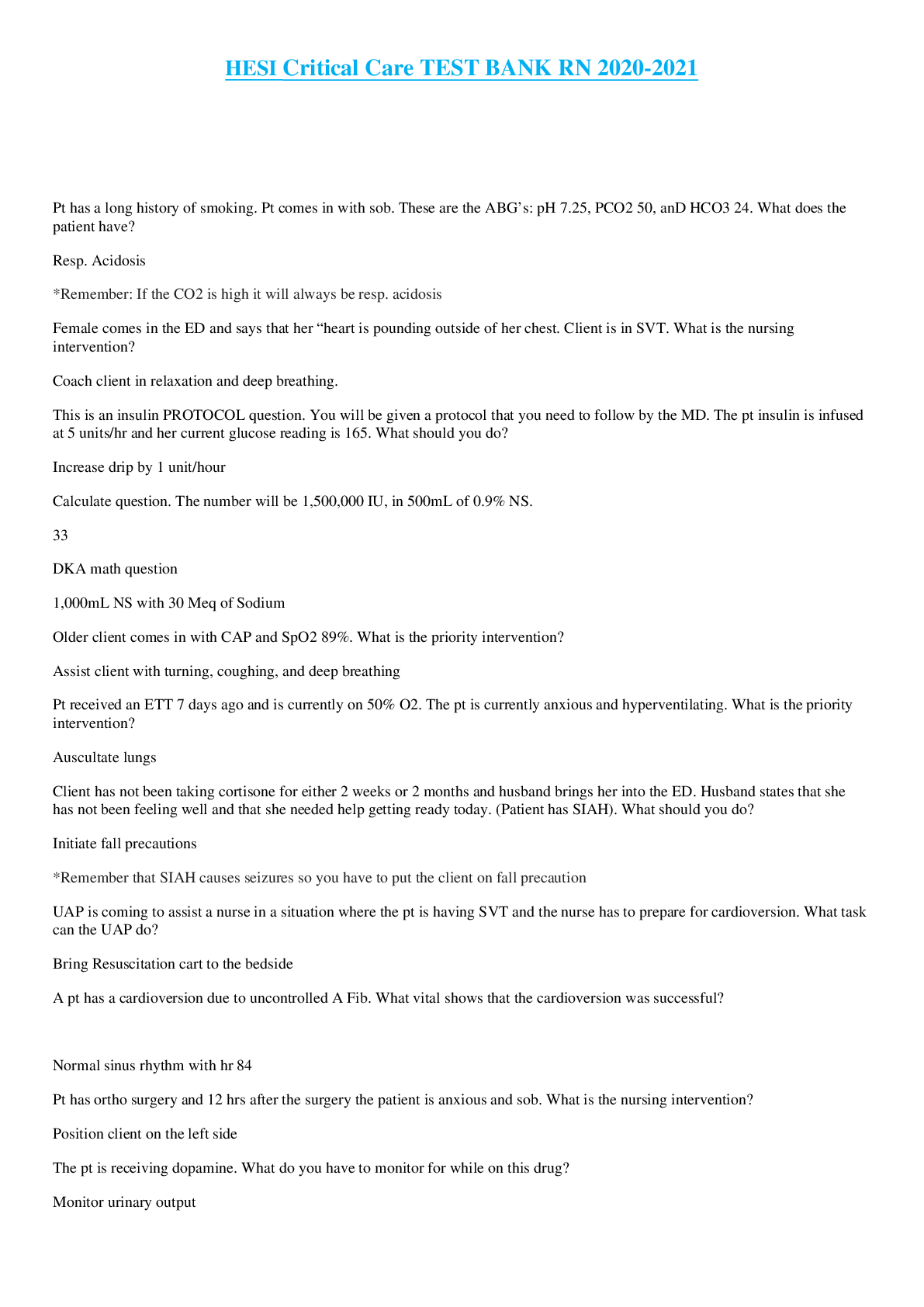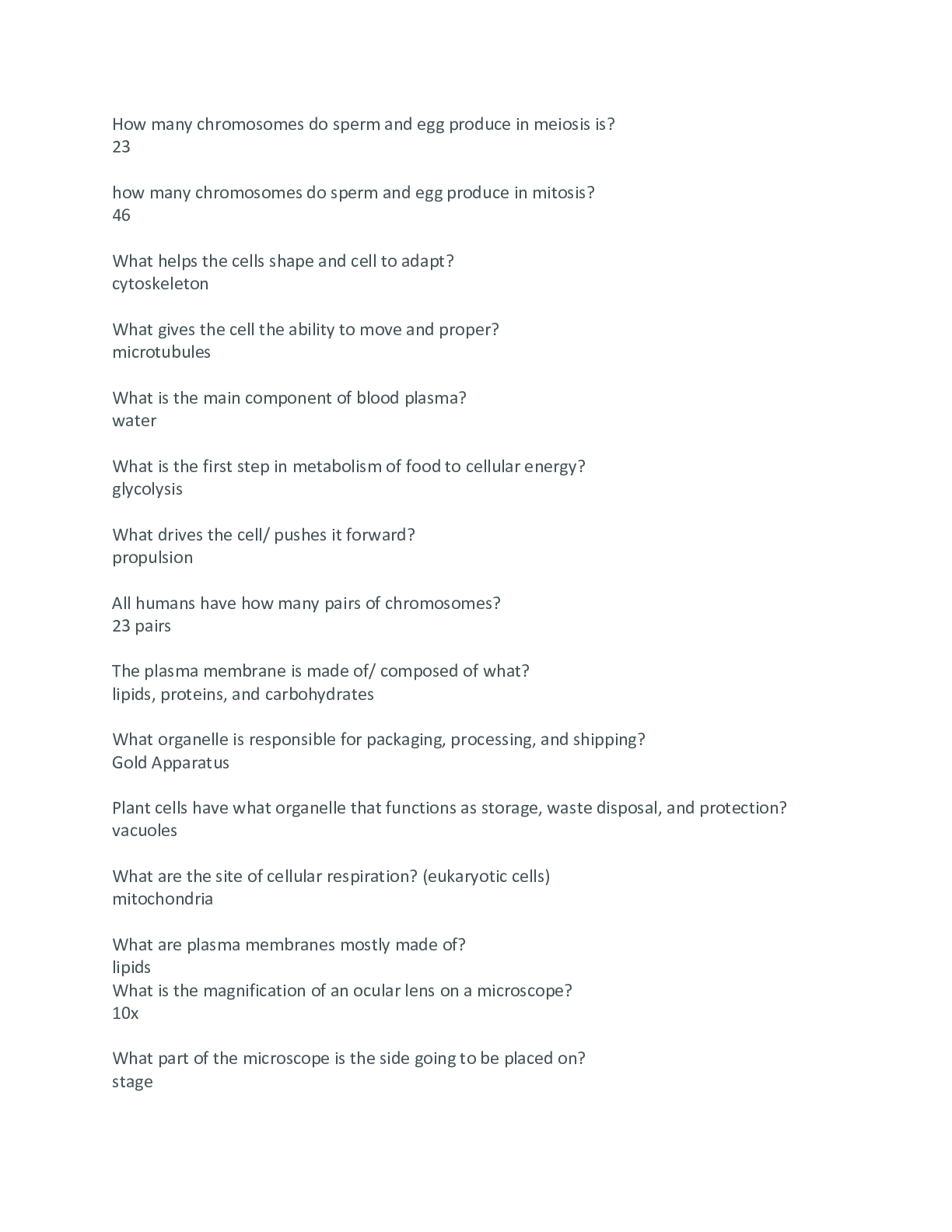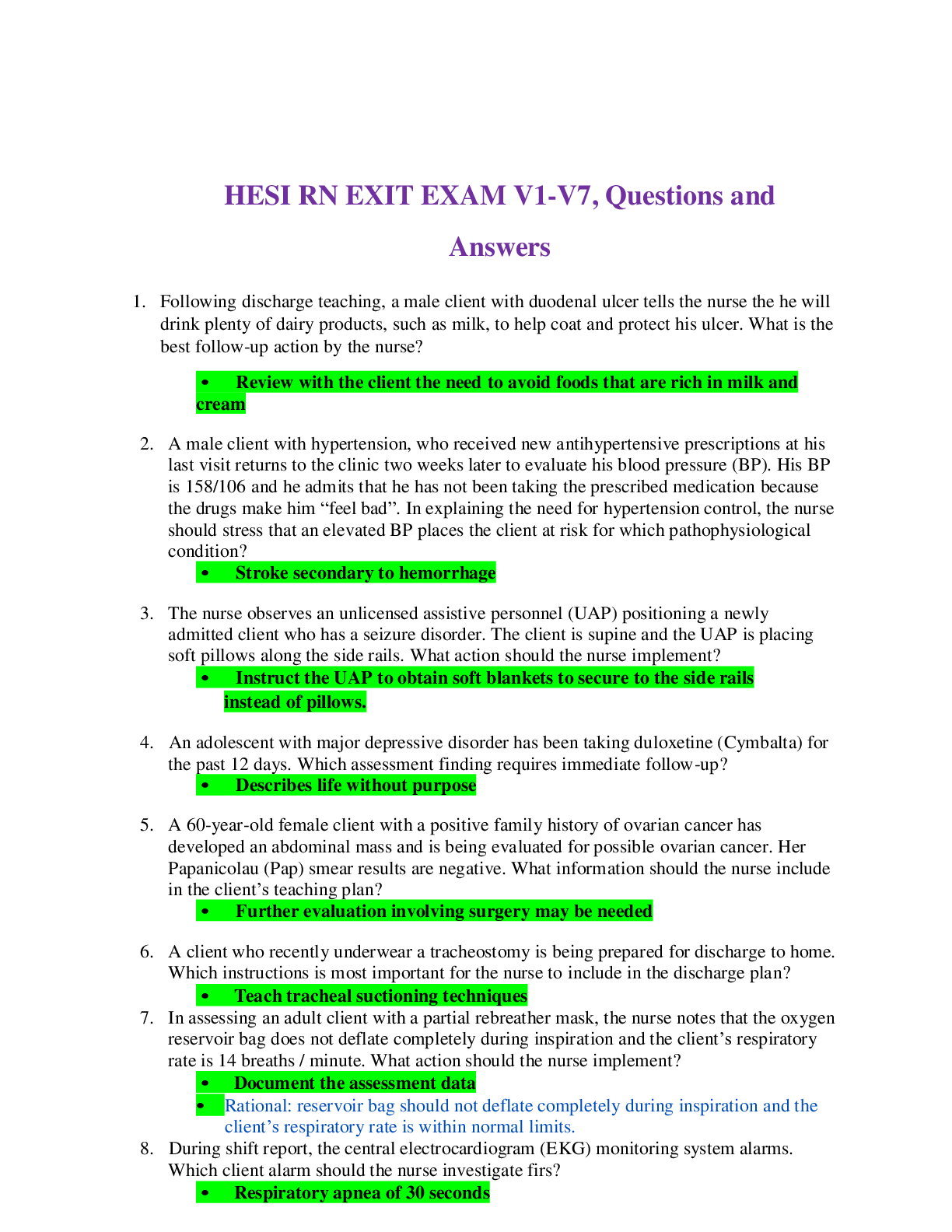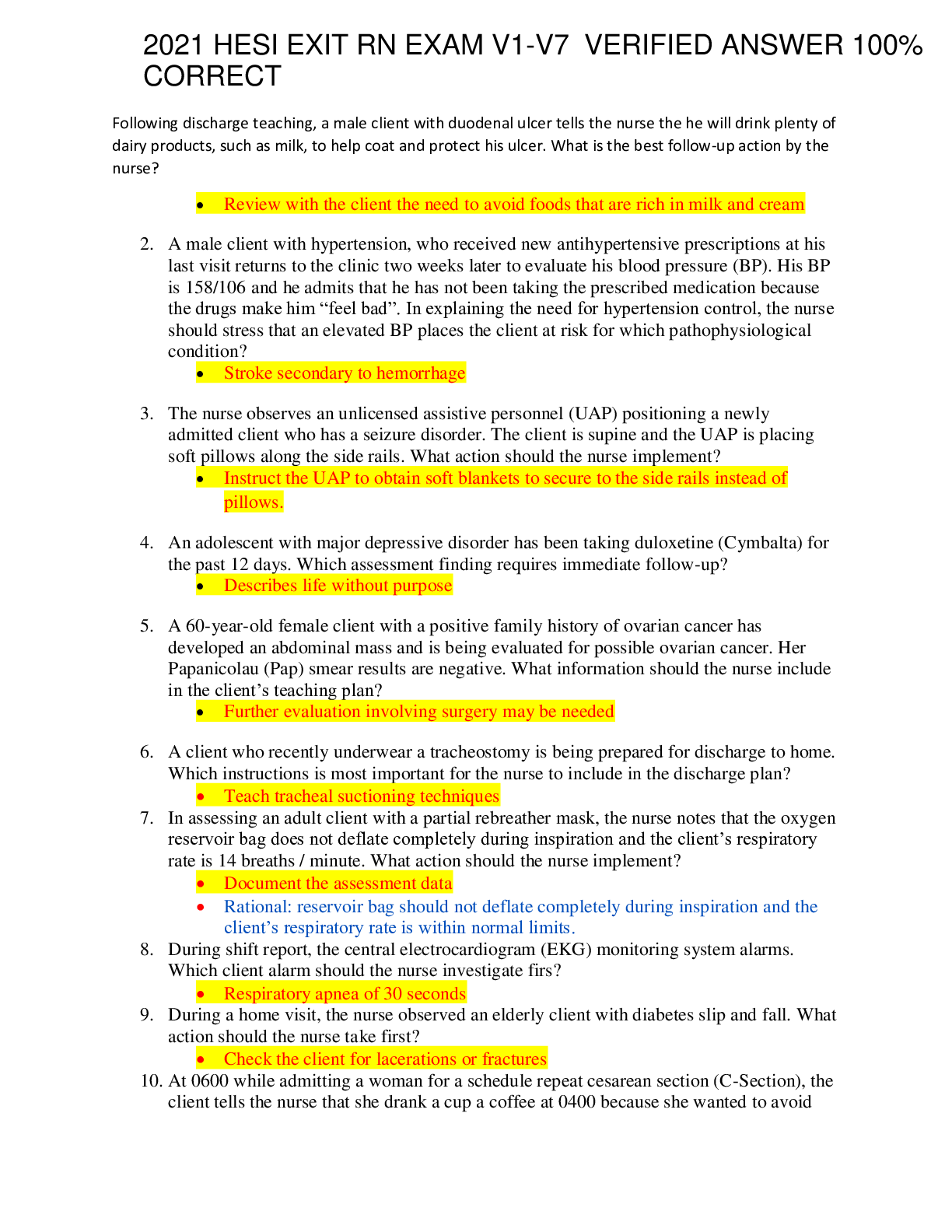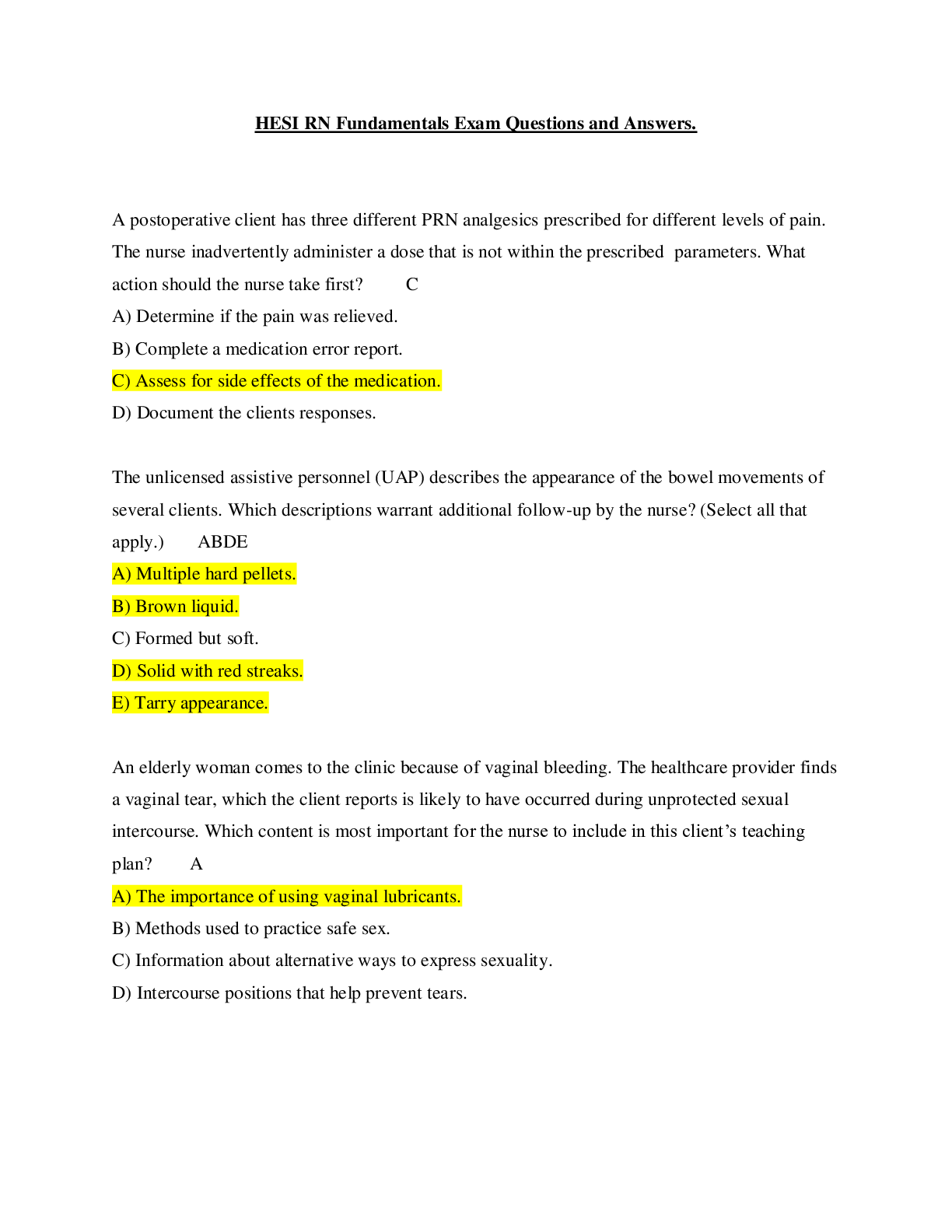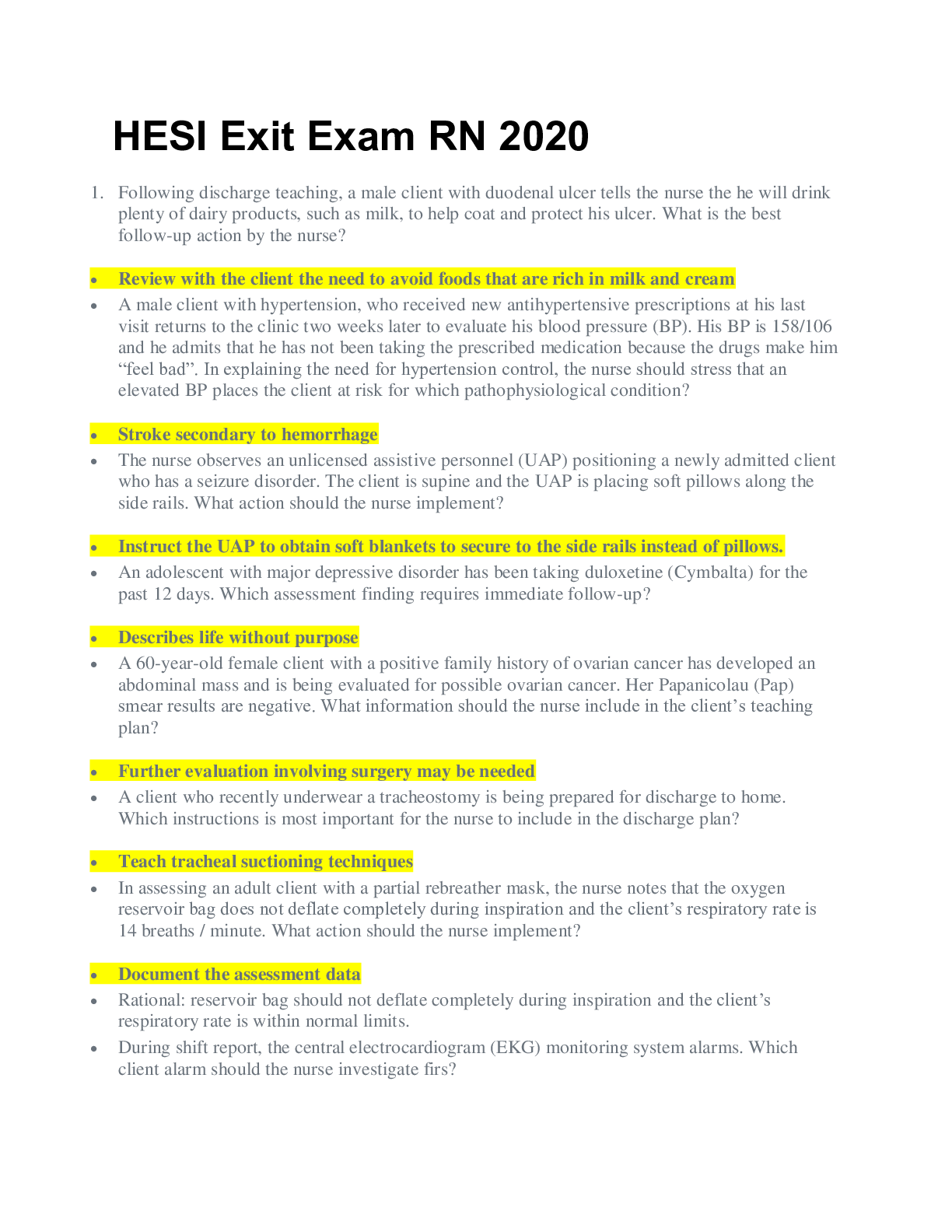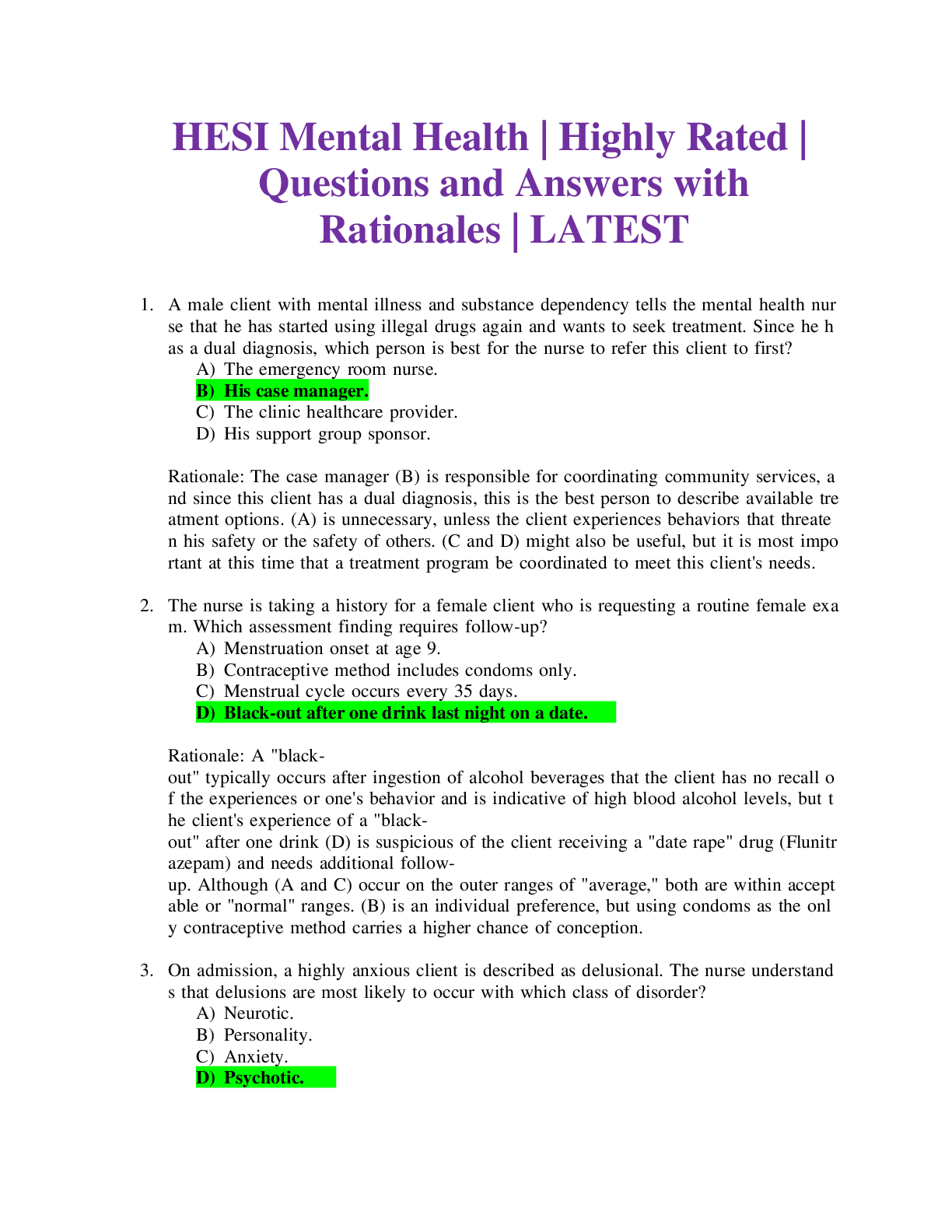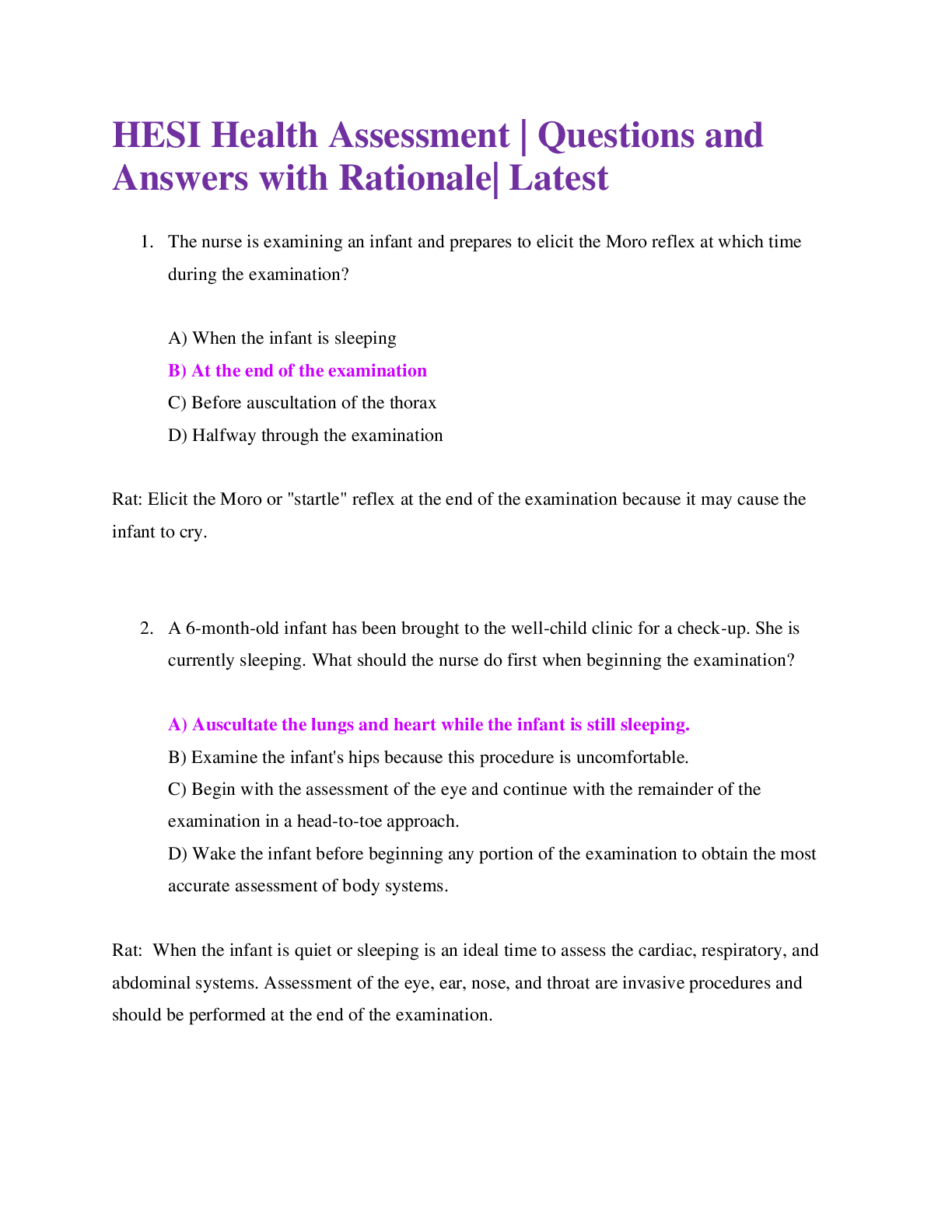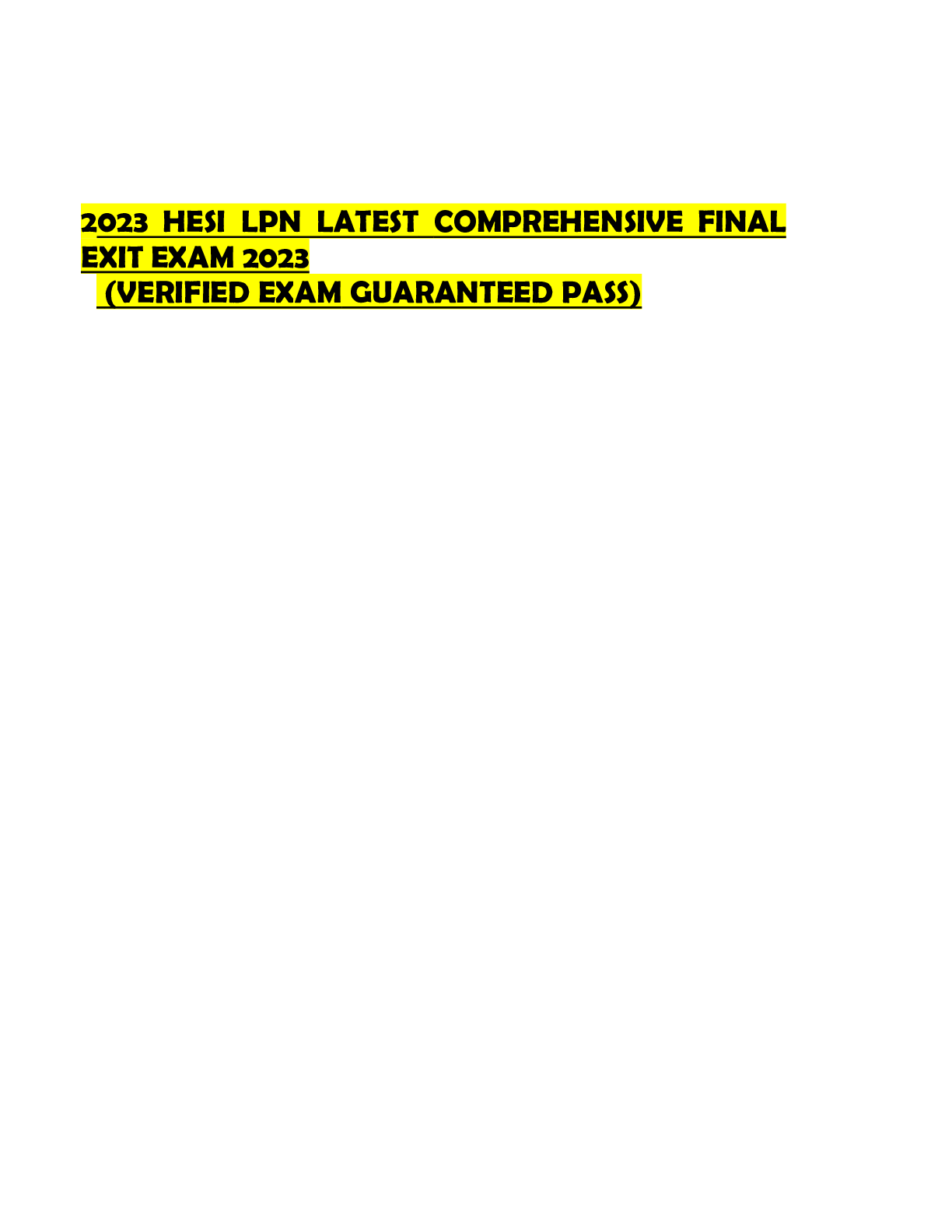MENTAL HESI 2 Questions/Answers (Latest Update)
Document Content and Description Below
MENTAL HESI 2 1. A male employee who is assessed weekly in the employee clinic for blood pressure because of a history of hypertension tells the nurse that he is so upset with one of his co-workers t... hat he would like to shoot him. What action should the nurse take first? a.) Determine if the client has a weapon available for use. b.) Inform the health care provider of the threat to harm a co-worker. c.) Notify security of the client’s intention to harm a co-worker. d.) Have the employee escorted to a mental health facility. 2. A male client who is participating in an anger management assignment asks if he can make a leather belt in occupational therapy. The client begins pounding the leather vigorously with a mallet to imprint designs on the belt. What defense mechanism is the client using? a.) Sublimation. b.) Suppression. c.) Regression. d.) Compensation. 3. A 20-year-old female client with schizophrenia is scheduled to receive risperidone (Risperdal) 2mg at bedtime. When the nurse attempts to administer the medication, the client states. “I am not going to take that medicine, and you can’t make me.” What action should the nurse take? a.) Administer the medication via a nasogastric tube. b.) Substitute an injectable form of the medication. c.) Encourage the client to take the medicine because it will help her sleep. d.) Document in the client’s record that the medication was refused. 4. An adult female client tells the nurse that though she is afraid her abusive boyfriend might one day kill her, she keeps hoping that he will change. What action should the nurse take first? a.) Discuss treatment options for abusive partners. b.) Explore client’s readiness to discuss the situation. c.) Determine the frequency and type of client’s abuse. d.) Report the finding to the police department. 5. A male client with bipolar disorder has not slept or eaten in four days. He paces and becomes increasingly agitated and loud while the nurse talks to his spouse. What intervention is the best for the nurse to implement at this time? a.) Move to a quiet area and provide peanut butter with crackers. b.) Walk with the client to the cafeteria and star as he eats lunch. c.) Request a full lunch tray from the dietary department. d.) Encourage the spouse to eat lunch with the client. 6. The nurse asks a female client with a borderline personality disorder, “How do you feel about your children not coming to visit this weekend?” The client looks out the window and replies, “I really don’t care.” Which response is best for the nurse to provide? a.) “I noticed you were looking out the window when discussing your feelings.” b.) “I think you’re lying and it bothers you that your children aren’t coming.” c.) “I think you should discuss your children not coming in the group meeting.” d.) “Why do you think your children didn’t want to come visit you this weekend?” 7. What is the most important goal of care for a client diagnosed with generalized anxiety disorder (GAD) who has been taking the benzodiazepine alprazolam (Xanax) long-term? The client will a.) Describe a decrease in anxiety using a 1 to 10 anxiety scale. b.) State the importance of not abruptly stopping the medication. c.) Not experience dizziness, lightheadedness, or sedation. d.) Attend scheduled individual and group therapy sessions. 8. The nurse is performing intake interviews at a psychiatric clinic. A female client with a known history of drug abuse reports that she has a heart attack four years ago. Use of which substance abuse places the client at highest risk for myocardial infarction. a.) Benzodiazepine b.) Marijuana c.) Methamphetamine d.) Alcohol 9. During a one-to-one session with the nurse, a female client who has been admitted for chronic depression and attempted suicide discloses her experience of sexual promiscuity and prostitution. When the nurse asks the client if she was ever sexually abused as a child, the client says, “I don’t remember, but my mother ran my father off when I was five.” The nurse should recognize that the client may be using which defense mechanism? a.) Denial b.) Projection c.) Regression d.) Repression 10. A client who refuses antipsychotic medications disrupts group activities, talks with nonsensical words and wanders into client’s room. The nurse decides that the client needs constant observation based on which of these assessment findings? a.) Disrupts group activities. b.) Wanders into the client’s rooms. c.) Talks with nonsensical words. d.) Refuses antipsychotic medications. 11. A women is brought to the psychiatric clinic by her husband who reports that his wife is reluctant to leave home because of what she describes as fear of open places and crowds. What is the best nursing diagnosis for this client? a.) High risk for injury related to chronic depression. b.) Anxiety related to poor self-image. c.) Ineffective individual coping. d.) High risk for injury related to isolation. 12. The atypical antipsychotic ziprasidone (Geodon) is prescribed for a client with a medical diagnosis of schizophrenia. After the client has been taking the medication for two weeks, the nurse assesses the drug’s effectiveness. Which client report suggests that the medication is helpful? a.) Is feeling less depressed? b.) Sleeps better at night. c.) The voices are quieter. d.) Nervousness has decreased. 13. A male college student brings his roommate to the campus clinic because the roommate has been talking to someone who is not present. The client tells the nurse that the voices are saying, “kill kill.” What question should the nurse ask the client next? a.) “When did these voices begin?” b.) “Have you taken any hallucinogens?” c.) “Are you planning to obey the voices?” d.) “Do you believe the voices are real?” 14. A male client is admitted to the psychiatric unit for recurrent negative symptoms of chronic schizophrenia and medication adjustment of risperidone (Risperdal). When the client walks to the nurse’s station in a laterally contracted position, he states that something has made his body contort into a monster. What action should the nurse take? a.) Medicate the client with the prescribed PRN antipsychotic trifluoperazine (Stela zine). b.) Offer the client a prescribed physical therapy treatment of hot pack for muscle spasms. c.) Administer the prescribed anticholinergic benztropine (Cogentin) for dystonia. d.) Direct the client to occupational therapy to distract him from somatic complaints. 15. The nurse on the evening shift received report that a client is scheduled for electroconvulsive treatment (ECT) in the morning. Which interventions should the nurse implement the evening before the scheduled ECT? a.) Implement elopement precautions. b.) Keep the client NPO after midnight. c.) Give client an enema at bedtime. d.) Hold all bedtime medications. 16. During the initial nursing interview, a client tells the nurse, “Sometimes my thoughts go so fast. Wonder if I can sell my fast car. Work is so boring. I wonder if I can get a transfer. Is it time to eat yet?” Which documentation should the nurse use to describe the client’s statements? a.) Demonstrates thought-blocking. b.) Uses incoherent speech. c.) Exhibits tangential thinking. d.) Displays the use of word salad. 17. A chronically depressed older male resident of a long-term care facility has become more reclusive and today refuses to leave his room. His family moved away from the local area and they are unable to visit as much as they had in the past. Which comment by the nurse is like to be most helpful to this client? a.) “May I sit with you for a while?” b.) “I know you are sad about not seeing your family as often, but they are visiting as much as they can.” c.) “Come into the recreation area. We have your favorite card game and I will play it with you.” d.) “Why do you want to stay in your room today?” 18. A client with borderline personality disorder tells the nurse, “You are the best nurse on the unit! The other nurses don’t care about me the way you do.” Which response is best for the nurse to provide this client? a.) “I am not the best nurse. All the nurses are good.” b.) “The other nurses and I are here to help you get better” c.) “You don’t think the other nurses care about you?” d.) “I do care about you as a person but nothing more.” 19. A male client who is admitted with bipolar disorder( manic psychosis), is placed in seclusion after unsuccessful attempts to de-escalate him during a sudden mood swing from laughter to jumping and screaming threats while having a plastic dinner knife. The client is given haloperidol (Haldol) 5 mg IM STAT prior to seclusion. What intervention is most important for the nurse to implement immediately after seclusion? a.) Observe for extrapyramidal symptoms, such as dystonia. b.) Release the client as soon as composure is regained. c.) Provide one-on-one observation at all times. d.) Secure the room with padded walls and minimal furnishings. 20. The nurse notes that a depressed female client has been more withdrawn and no communicative during the past two weeks. Which intervention is most important to include in the updated plan of care for this client? a.) Engage the client in non-threatening conversations. b.) Schedule a daily conference with the social worker. c.) Encourage the client’s family to visit more often. d.) Encourage the client to participate in group activities. 21. A young adult male client is admitted to the psychiatric unit because of recent suicide attempt. His wife filed for divorce six months ago, he lost his job three months ago, and his best friend moved to another city two weeks ago. Which intervention should the nurse include in the client’s plan of care? a.) Encourage the client to interact with persons who are recovering from depression. b.) Allow the client time alone to sort out his feelings. c.) Avoid discussing subjects that upset the client. d.) Encourage activities that allow the client to exert control over his environment. 22. A client is admitted to the mental health unit and sits in the corner of the day room. When the nurse begins the admission assessment interview, the client is guarded, suspicious, and resists talking. What action should the nurse implement? a.) Attempt to ask the client simple questions. b.) Postpone the client interview until the next day. c.) Ask another nurse to talk with the client. d.) Document the client’s paranoid behavior. 23. The nurse is admitting a male client who takes lithium carbonate (Eskalith) twice a day. Which information should the nurse report to the healthcare provider immediately? a.) Short term memory loss. b.) Depressed affect. c.) Five pound weight gain. d.) Nausea and vomiting. 24. A young female client is admitted to the emergency room because she was raped that evening by her date. How should the nurse record the client’s chief complaint in the medical record? a.) Client reported that she had sexual relations against her will. b.) Client claims that she was forced to participate in sexual intercourse. c.) Client has been sexually assaulted. d.) Client states, “my date raped me tonight.” 25. An older female adult who lives in a nursing home is loudly demanding that the nurse call her son who has been deceased for five years. Which intervention should the nurse implement? a.) Assist the client to call the phone number she has. b.) Remind the client that her son died five years ago. c.) Escort the client to a private area. d.) Direct the client to a new activity. 26. A teenaged male client is admitted to the postoperative unit following open reduction of a fractured femur which occurred when he fell down the stairs at a party. The nurse notices needle marks on the client’s arms and plans to observe for narcotic withdrawal. Early signs of narcotic withdrawal include which assessment findings? a.) Vomiting, seizures, and loss of consciousness. b.) Depression, fatigue, and dizziness. c.) Hypotension, shallow respirations, and dilated pupils. d.) Agitation, sweating, and abdominal cramps. 27. Two days after his last drink, a male alcoholic client becomes agitated, and yells at his wife and children, “Stay away from me!” His vital signs are elevated. What nursing diagnosis has the highest priority? a.) High risk for social isolation. b.) Altered parenting. c.) Ineffective individual coping. d.) High risk for injury. 28. The nurse interacts with a male client who is very depressed and slow to respond to questions. The nurse asks the client to explain how he is feeling, but the client looks down at the table. What action would be best for the nurse to implement? a.) Return at a later time to talk. b.) Ask if the client heard the question. c.) Wait for the client to respond. d.) Ask a different question. 29. A 15-year-old male with mild mental retardation is admitted to the adolescent unit because he repeatedly refuses to complete personal hygiene. The healthcare provider prescribes that the client brush his teeth three times a day. In the psychiatric team conference, a behavior modification program is recommended to engage the client’s participation. When implementing this technique, what reinforcement is best for the nurse to provide? a.) Privilege restriction or fines for refusals to complete a hygiene task. b.) Preferred activities or tokens for each compliance. c.) Unit tasks for each omission of teeth brushing. d.) Candy for each successful hygiene task, like brushing his teeth. 30. When developing a plan of care for a client to the psychiatric unit following aspiration of a caustic material related to a suicide attempt, which nursing diagnosis has the highest priority? a.) Risk for injury. b.) Ineffective coping mechanisms. c.) Alteration in comfort. d.) Ineffective breathing patterns. 31. A female client with obsessive-compulsive personality disorder is admitted to the hospital for a cardiac catheterization. The afternoon before the procedure, the client begins to keep detailed notes of the nursing care she is receiving, and reports her findings to the nurse at bedtime. What action should the nurse implement? a.) Ask the client to explain why she is keeping a detailed record of her nursing care. b.) Teach the client strategies to control her obsessive-compulsive behavior. c.) Encourage the client to express her feelings regarding the upcoming procedure. d.) Explain to the client that her behavior invades the rights of the nursing staff. 32. A young adult female client is admitted to a psychiatric facility with a medical diagnosis of bulimia nervosa. Which nursing intervention has the highest priority? a.) Schedule the client for group therapy with other bulimic clients. b.) Assign the client’s care to a nurse of approximately the same age. c.) Monitor the client carefully for binging activities. d.) Assess and report the client’s electrolyte status to the healthcare provider. 33. Which client information indicates the need for the nurse to use the CAGE questionnaire during the admission interview? a.) Reports difficulties with short term memory since a traumatic brain injury. b.) Client’s medication history includes the frequent use of antidepressants. c.) Describe self as a social drinker who drinks alcoholic beverages daily. d.) Medical history includes that the client was recently sexually assaulted. 34. An adolescent with major depressive disorder has been taking duloxetine (Cymbalta) for the past 12 days. Which assessment finding requires immediate follow-up? a.) Describes life as without purpose. b.) Exhibits an increase in sweating. c.) States is often fatigued and drowsy. d.) Complains of nausea and loss of appetite. 35. The nurse is using the CAGE questionnaire as a screening tool for a client who is seeking help because his wife said he had a drinking problem. What information should the nurse explore in depth with the client based on this screening tool? a.) Cancer screening results, anger, gastritis, daily alcohol intake. b.) Efforts to cut down, annoyance with questions, guilt, drinking as an “Eye-opener.” c.) Consumption, liver enzyme, gastrointestinal complaints and bleeding. d.) Minimizes drinking, frequently misses family events, guilt about drinking, amount if daily intake. 36. A teenaged client, a heroin addict, is admitted to the unit for detoxification. What intervention is most important for the nurse to initiate during the first 24 hours after admission? a.) Assign the client to a teen support group. b.) Assess intake and output. c.) Monitor for wheezing and apnea. d.) Limit visitors to family members only. 37. A client is admitted to the mental health unit for feelings of depression secondary to a positive HIV report. To provide a safe milieu for this client, what action should the nurse take? a.) Replace paper trash bags with plastic biohazard bags. b.) Remove soft drink cans from the nurse’s desk and patient lounge. c.) Ensure that prescribed medications are kept in a safe place in the room. d.) Take the client’s cellular telephone and provide a telephone in the room. 38. The nurse documents that a male client with paranoid schizophrenia is delusional. Which statement by the client confirms this assessment? a.) “The voices are telling me to kill the next person I see.” b.) “The fire is burning my skin away right now.” c.) “The snakes on the wall are going to eat me.” d.) “The nurse at night is trying to poison me with pills.” 39. A male client turns over a table in the dayroom of a psychiatric unit and threatens to throw a chair at another client. Which action is most important for the nurse to implement? a.) Calmly approach the client and remove the chair from the client. b.) Obtain staf f assistance to help diffuse the escalating situation. c.) Offer feedback about what is observed about the client’s behavior. d.) Summon the hospital security guards as a “show of force. 40. A client is admitted to the mental health unit with a diagnosis of adjustment disorder and depressed mood. Findings of which diagnostic tests provide the most information for developing this client’s plan of care? a.) Electrocardiogram. b.) Basic metabolic panel. c.) Urine drug screen. d.) Complete blood count. 41. The client is being admitted to the psychiatric unit for depression and self-deprecation. Which intervention should the nurse implement first? a.) Meet with the client’s significant other to obtain a history. b.) Establish a therapeutic relationship with the client. c.) Ask the client if he has a plan to harm himself. d.) Complete the client’s psychiatric admission assessment. 42. An 8-year-old client is brought to the emergency department with a suspected drug overdose. Which information is most important for the nurse to obtain from the family? a.) Past history of depression. b.) The drug that was ingested. c.) Reason for the suicide attempt. d.) The time since the drug ingestion. 43. The nurse is assess a male client with paranoia. Which behavior can this client be expected to? a) Tries to run the unit, telling everyone what to do and when to do it. b) Is openly hostile the others for no apparent reason. c) Talks to voices only he can hear. d) Repeatedly tries to commit suicide. 44. The nurse completes a health assessment for a client a long alcohol dependency at health finding is the client most likely to report? a) Pancreatitis. b) Emphysema. c) Thombophlebitis. d) Crohn’s Disease. 45. A client postpartum depression receive prescription Sertraline (Zoloft). What information is most important to include in client teaching? A) Avoid processed meats, red wine, and swiss cheese. B) Contact health care provider immediately if muscle stiffness. C) Contact health care provider suicidal ideation. D) Increase activity level to include a daily exercise rotine. 46. When communicating a client Bipolar disorders , the nurse realizes that the client is suddenly becoming tense and verbally abusive. What action should the nurse take? a) Ask for assistance in placing the client in four point restrains. b) Move client to an area that is close to occupational therapy. c) Suggest physical activity to the client such as taking or walk. d) Encourage the client to participate in board game of chess. [Show More]
Last updated: 1 year ago
Preview 1 out of 9 pages
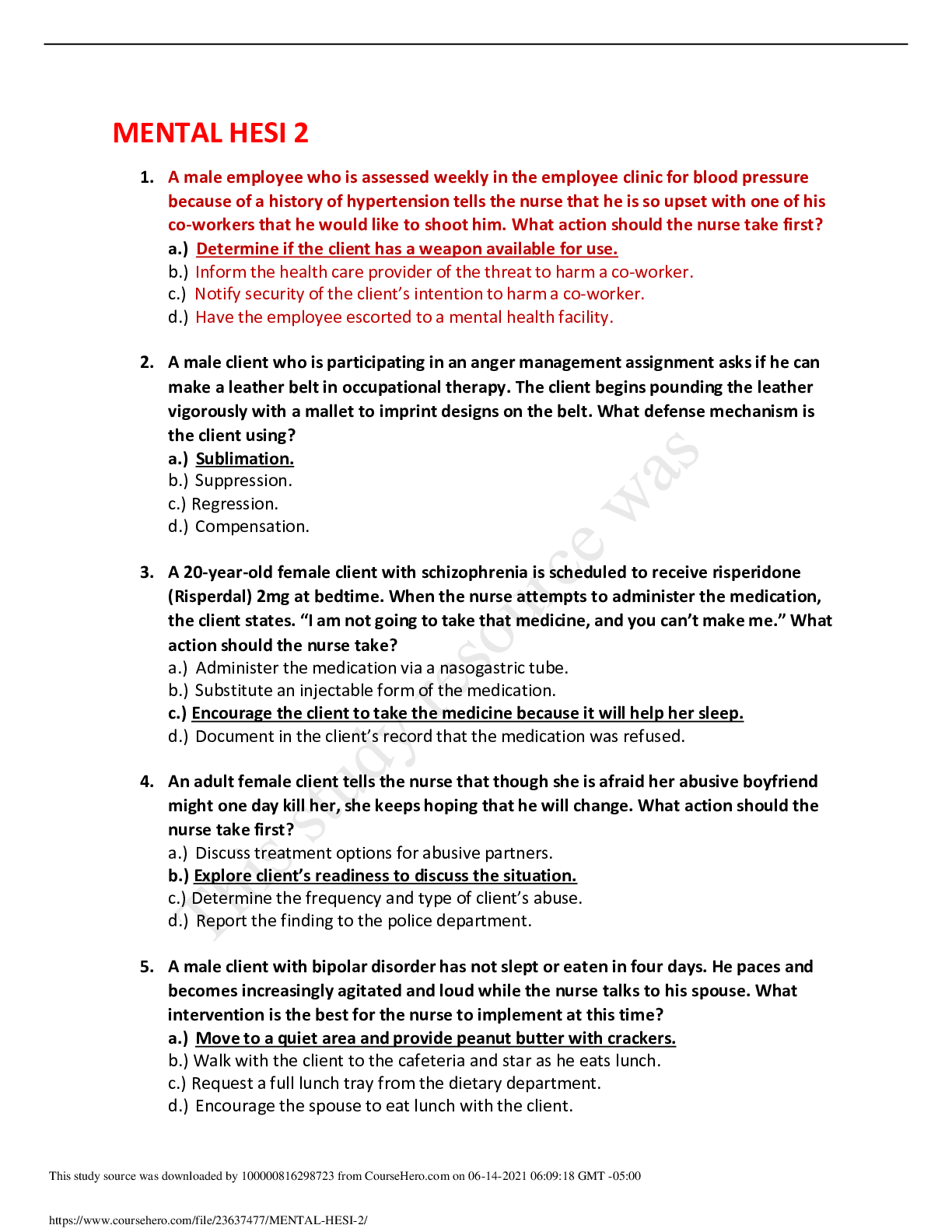
Also available in bundle (2)

ALL MENTAL HESI 1,2,3,4,5,6 &7 QUESTIONS/ANSWERS (COMPLETE UPDATE)
MENTAL HESI 1 MENTAL HESI 2 MENTAL HESI 3 MENTAL HESI 4 MENTAL HESI 5 MENTAL HESI 6 MENTAL HESI 7
By Good grade 2 years ago
$20.5
7

Psychiatric Exam File (BUNDLE) 2022/23
Psychiatric Exam File 2022/23
By Good grade 2 years ago
$20.5
23
Reviews( 0 )
Document information
Connected school, study & course
About the document
Uploaded On
Jun 14, 2021
Number of pages
9
Written in
Additional information
This document has been written for:
Uploaded
Jun 14, 2021
Downloads
0
Views
78

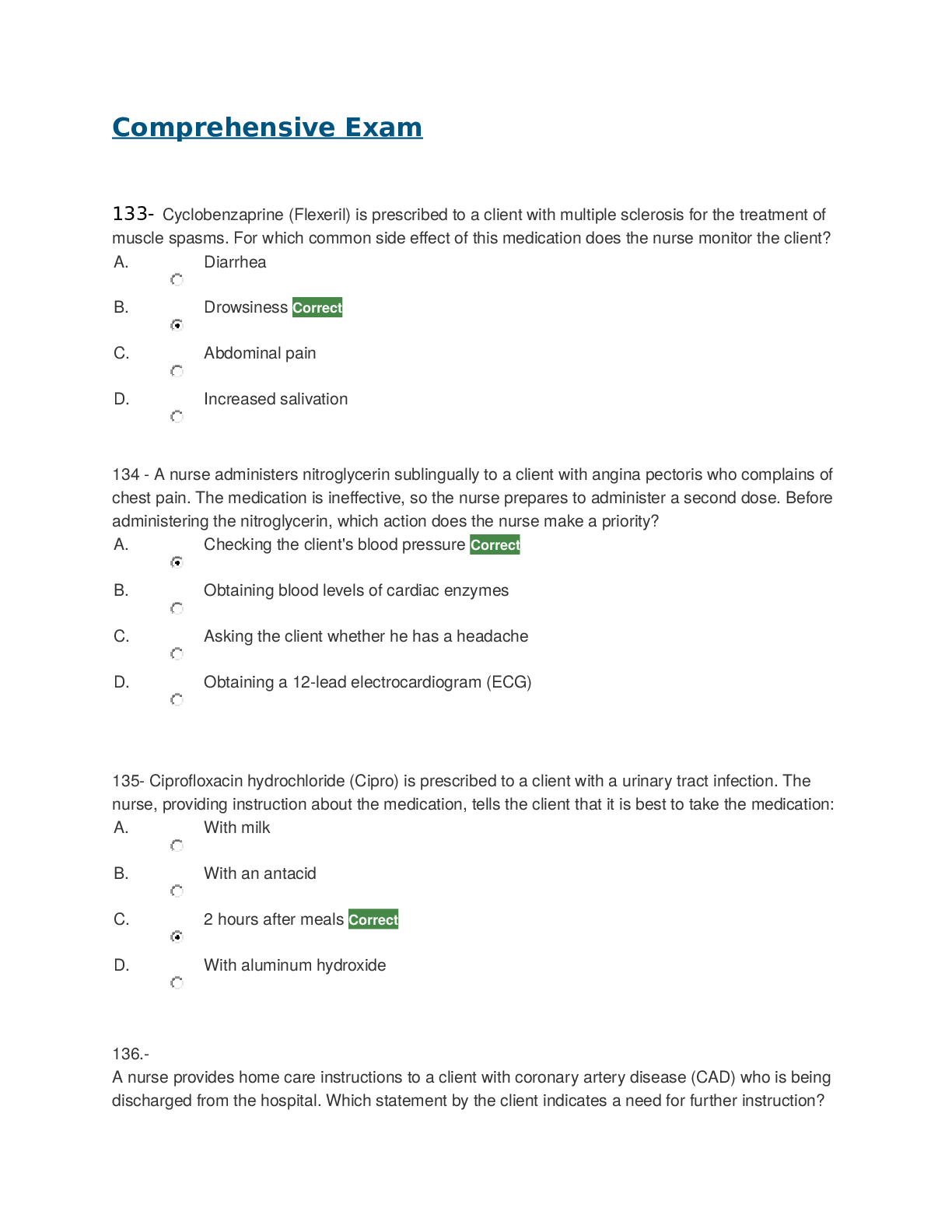
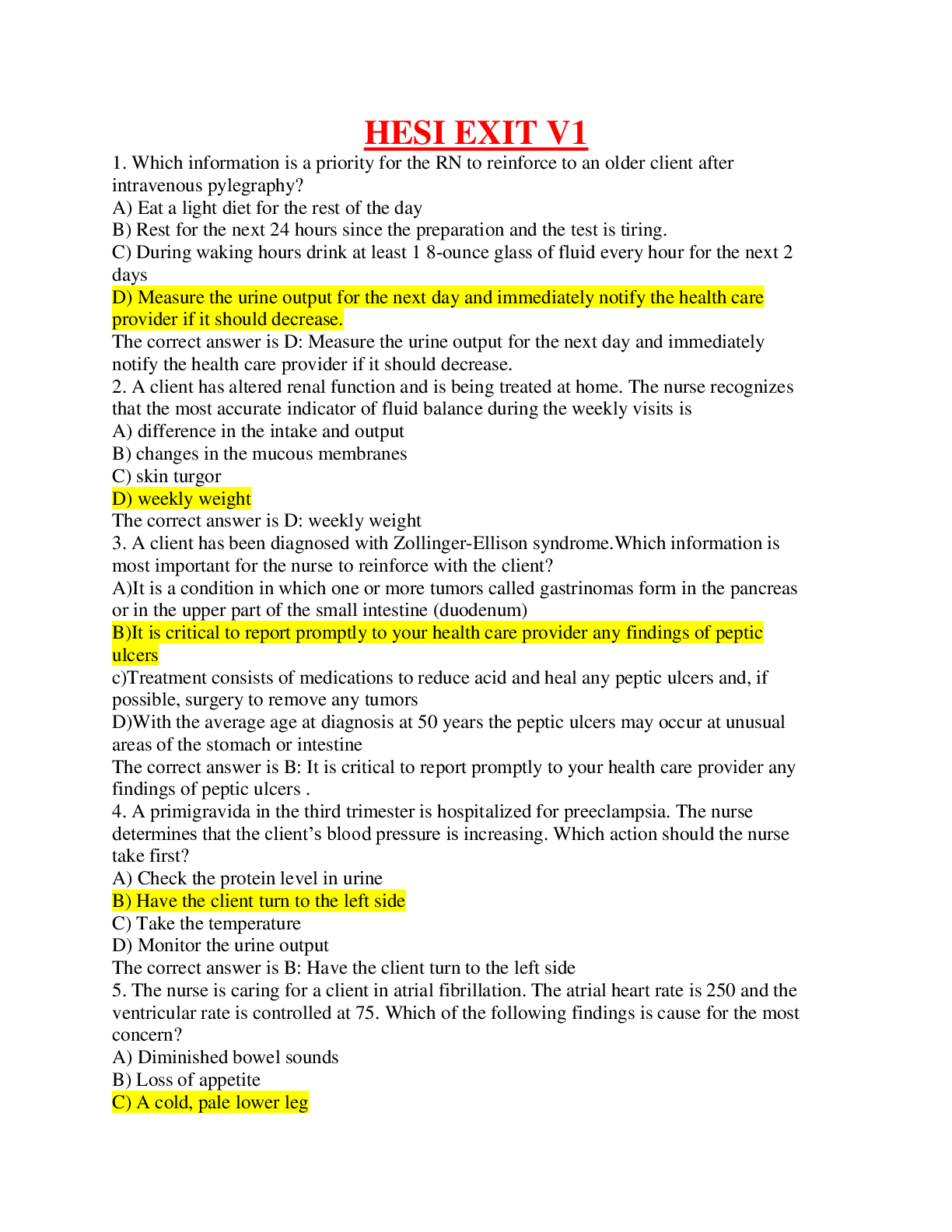
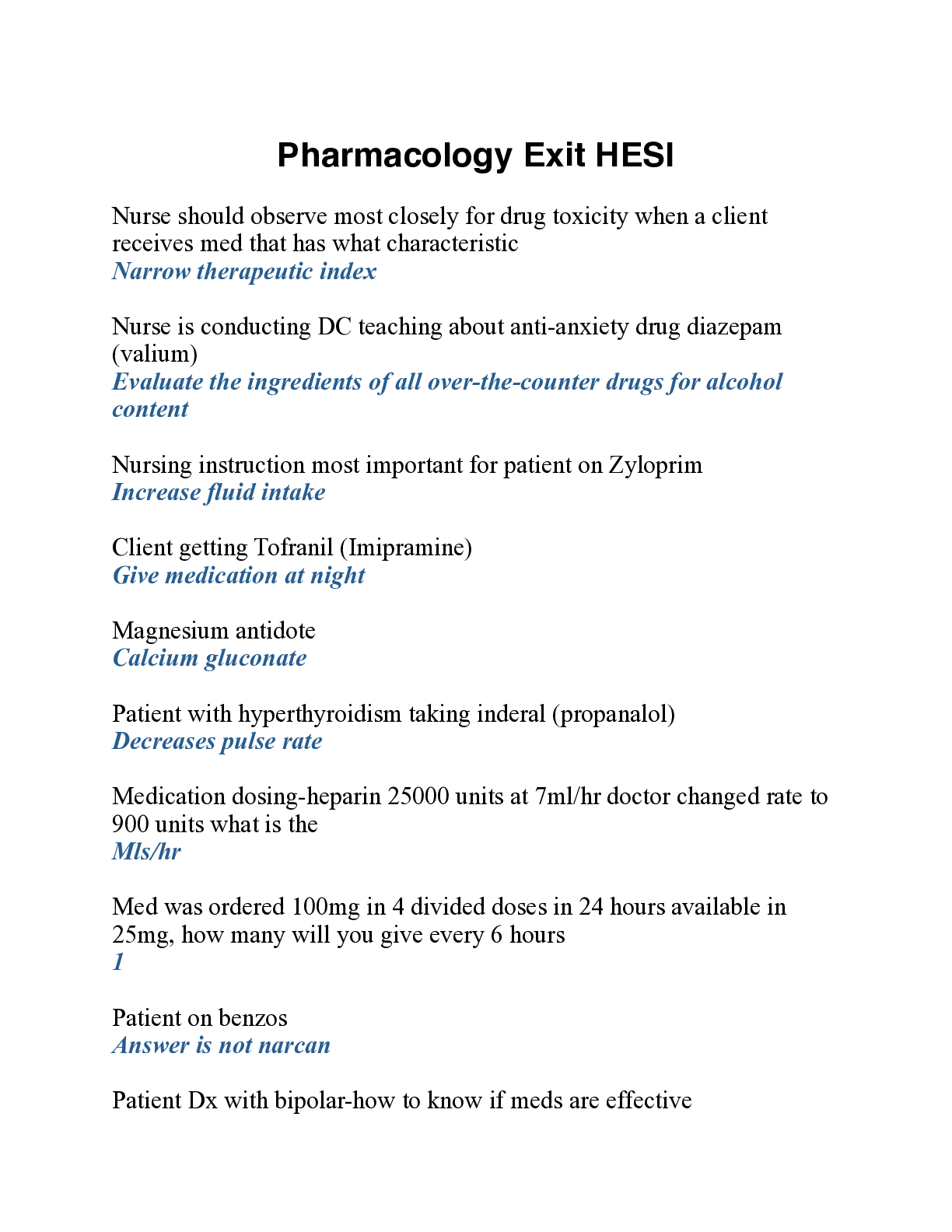
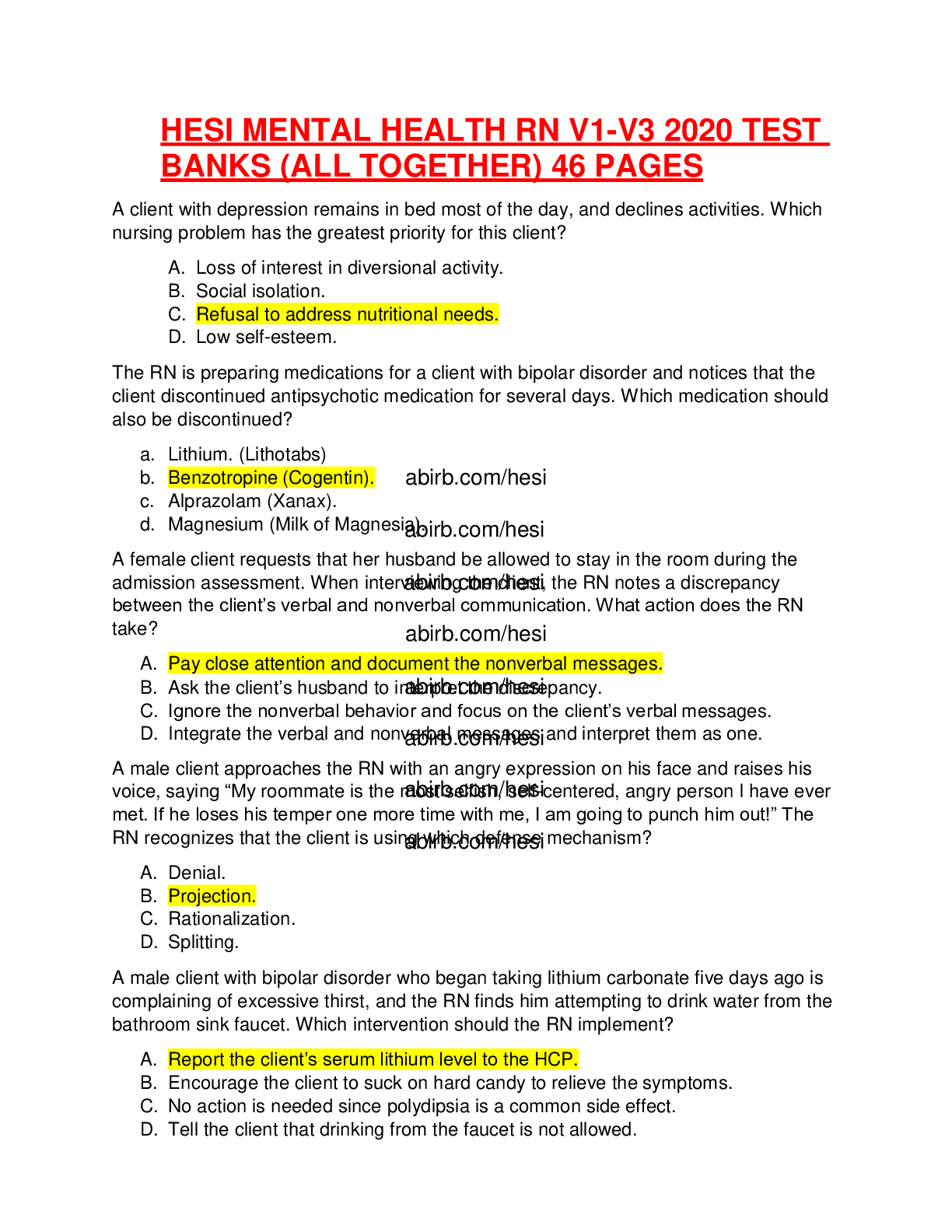

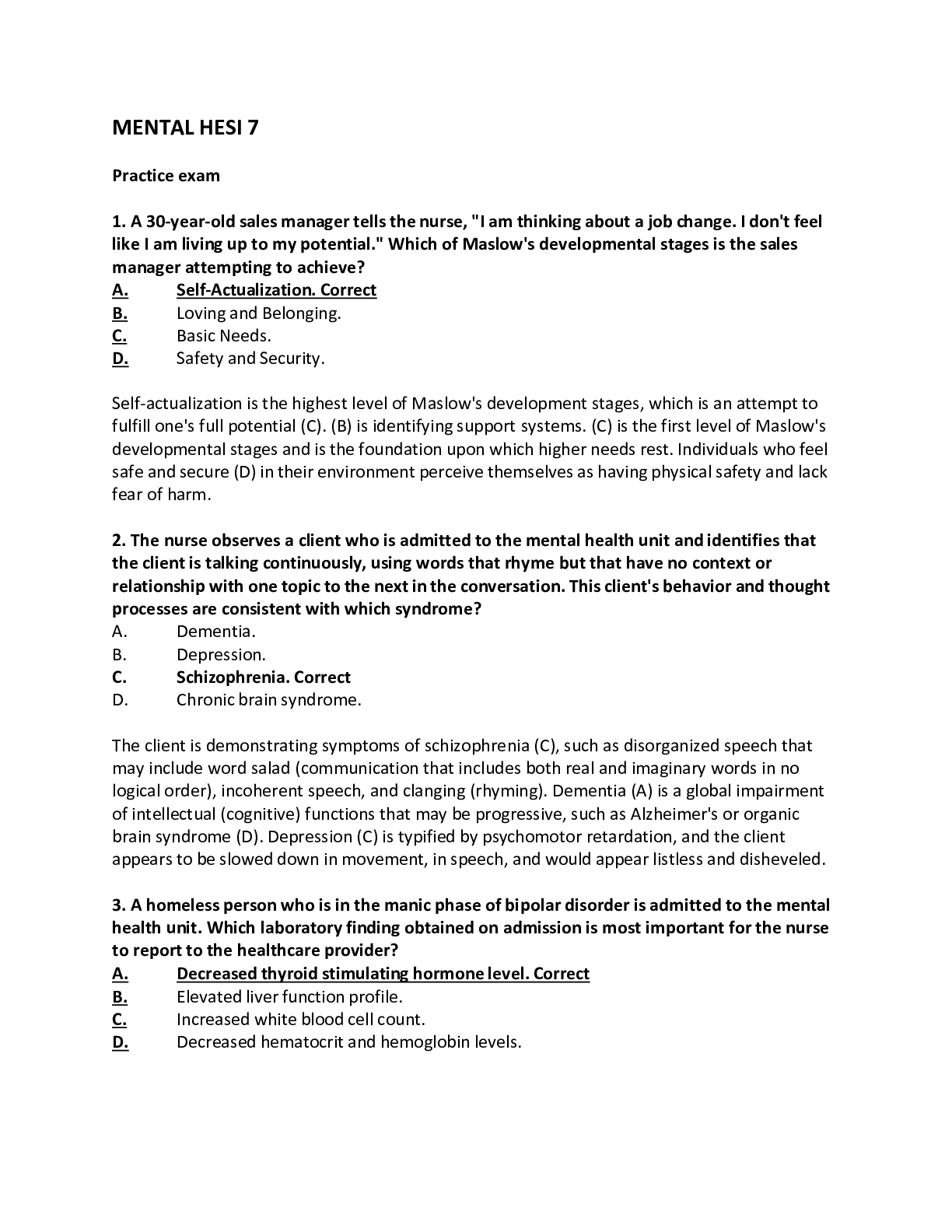
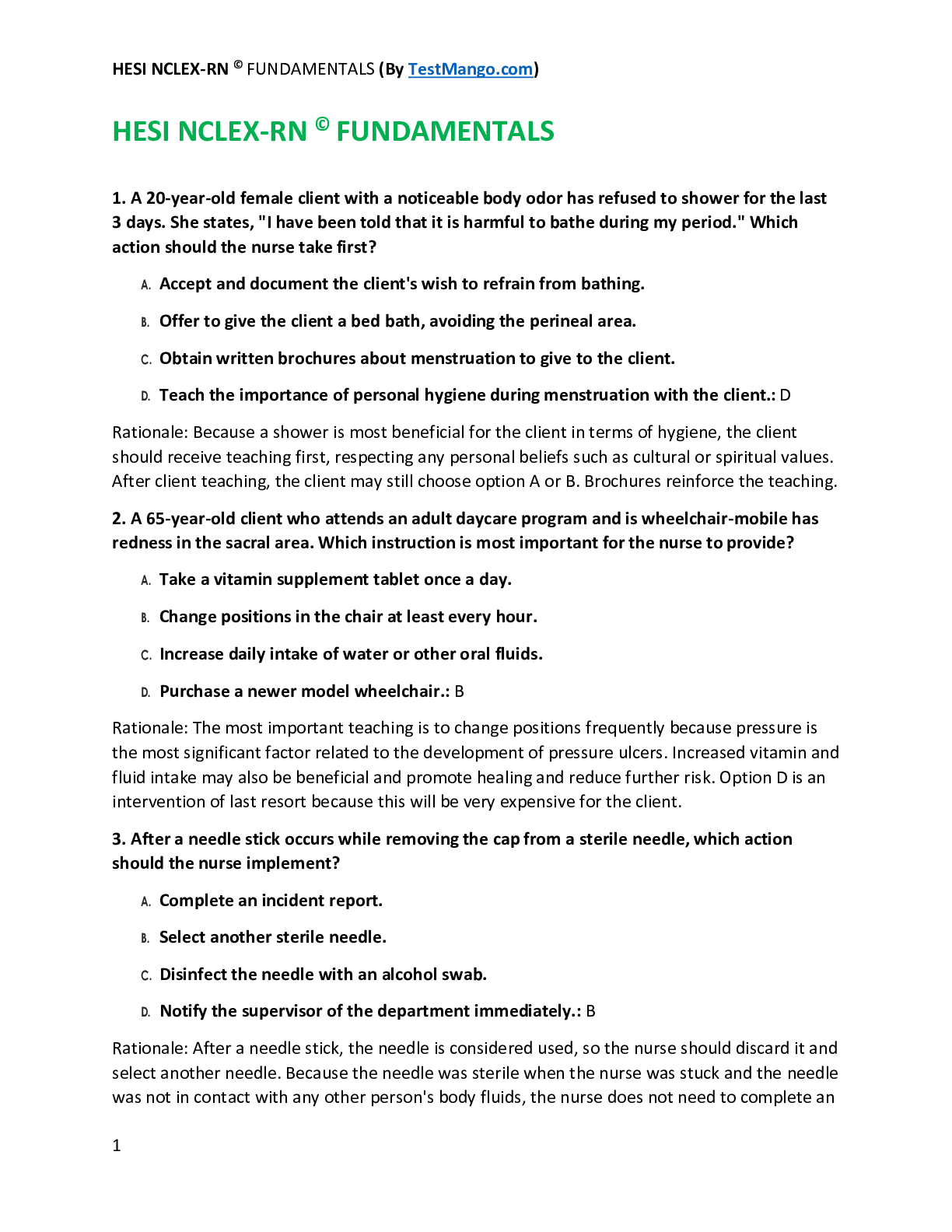
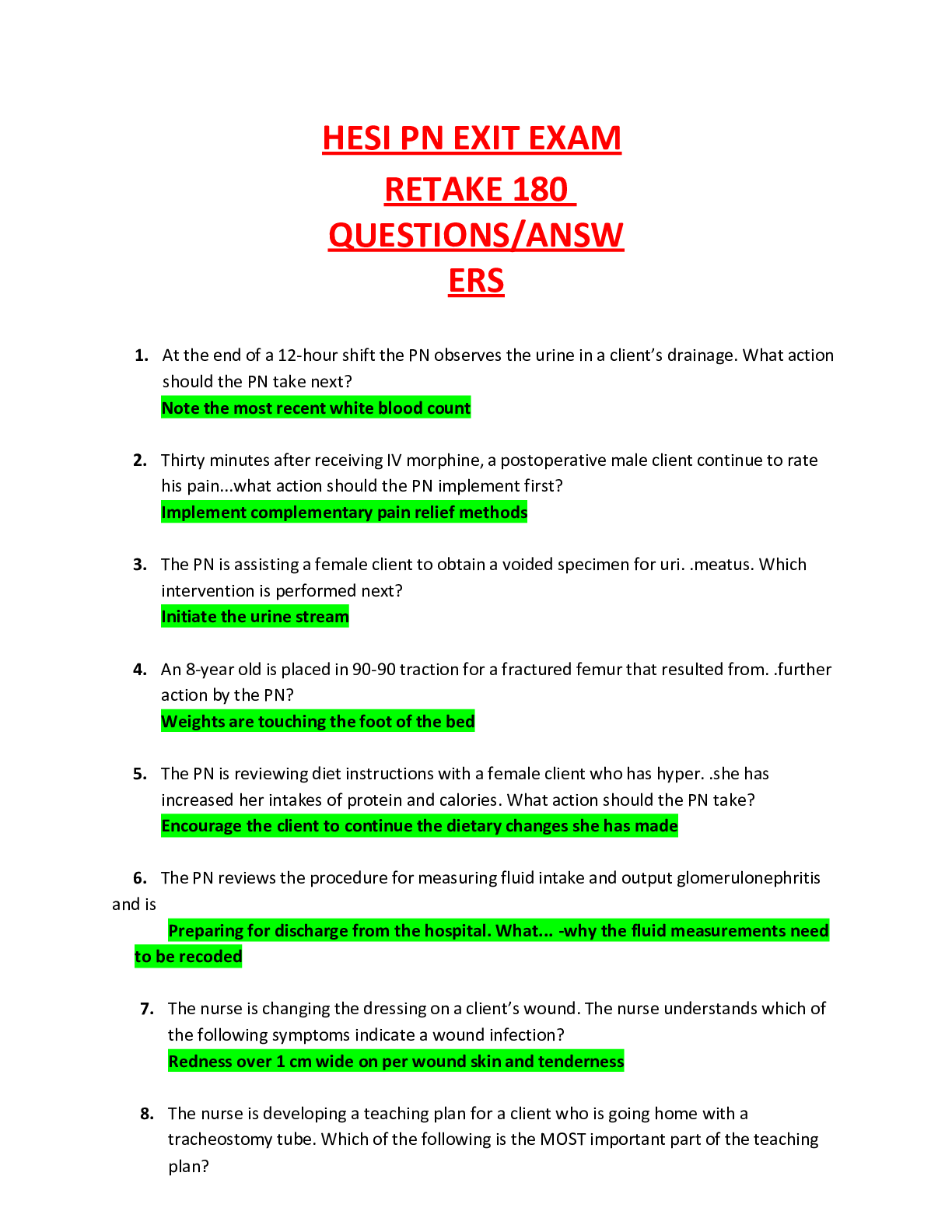


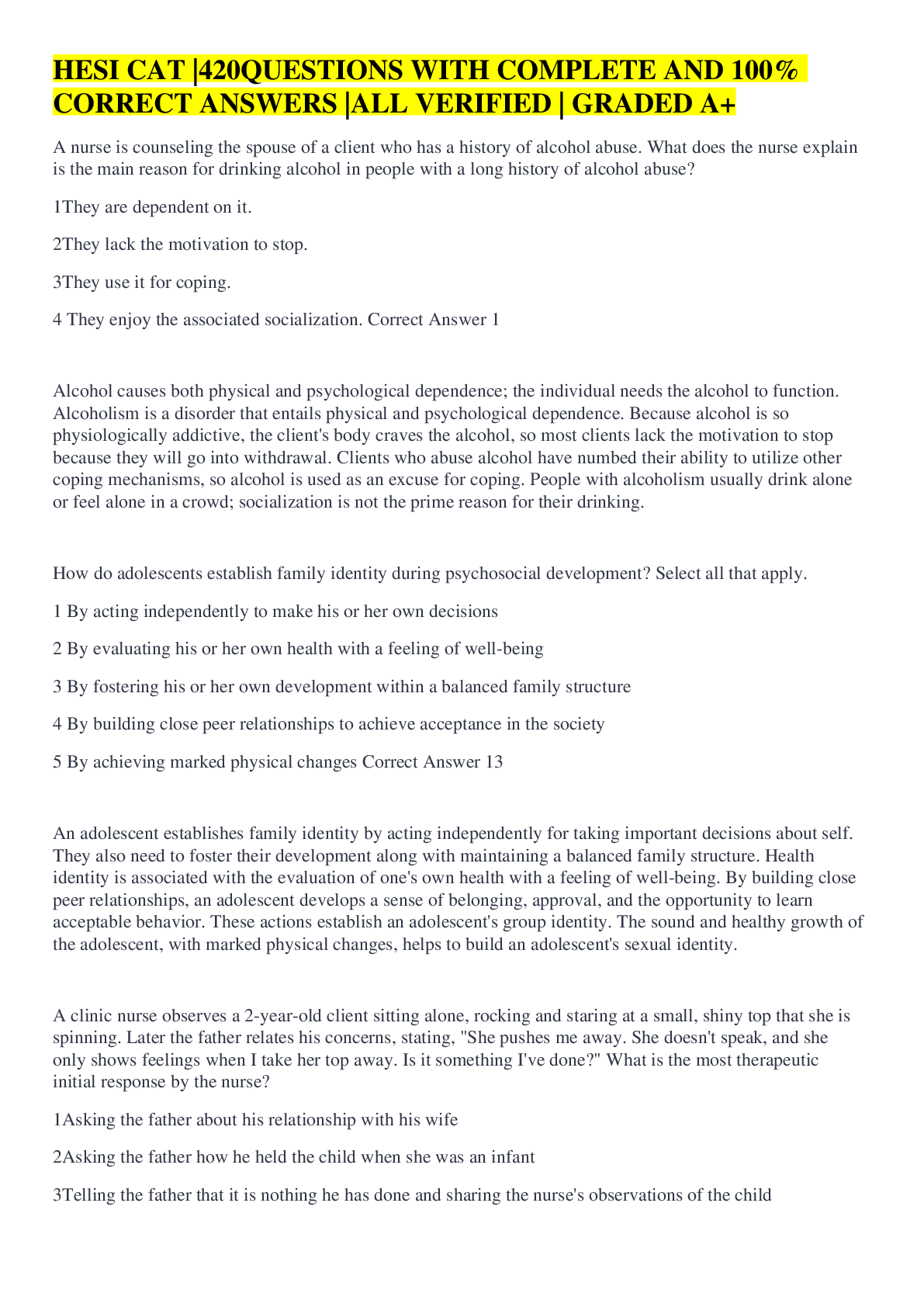
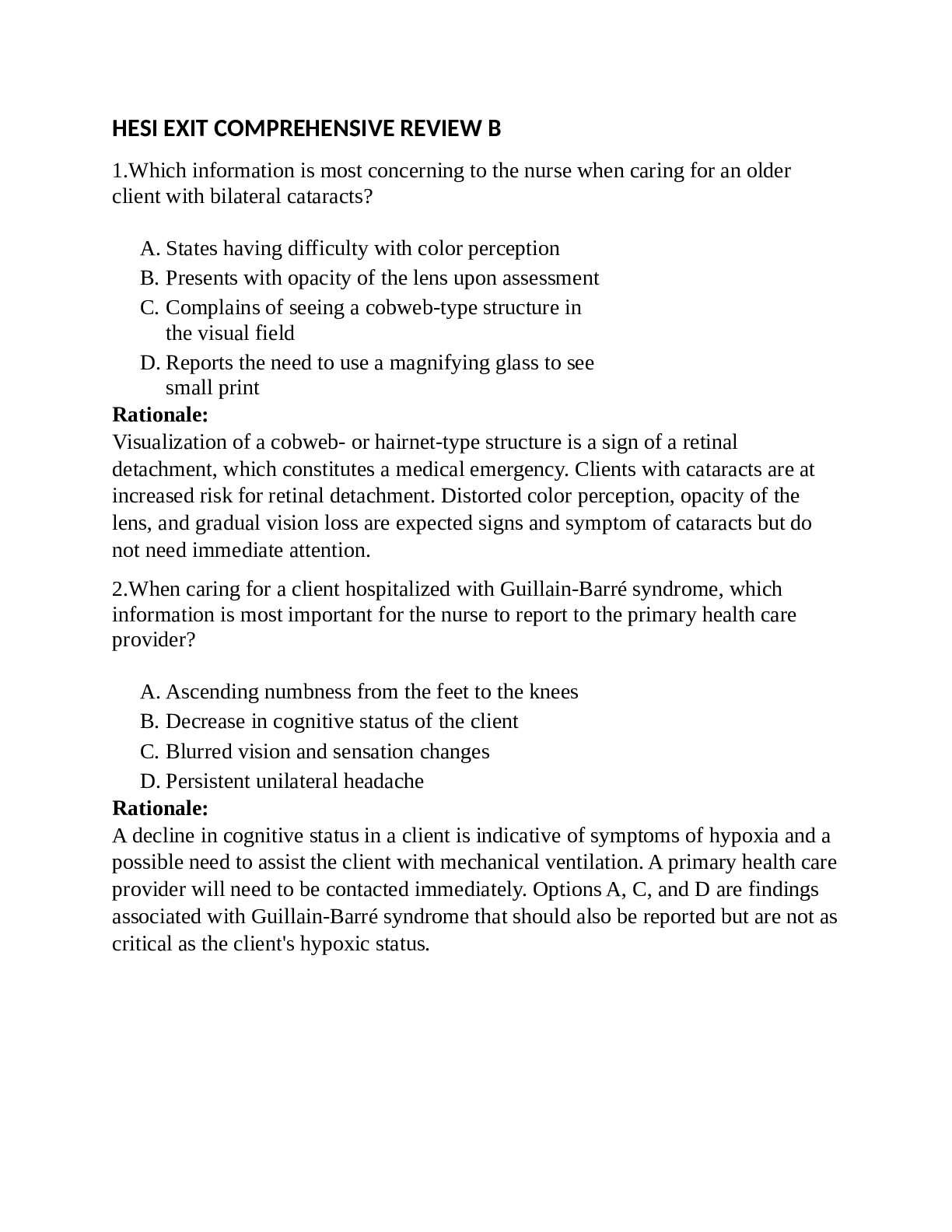
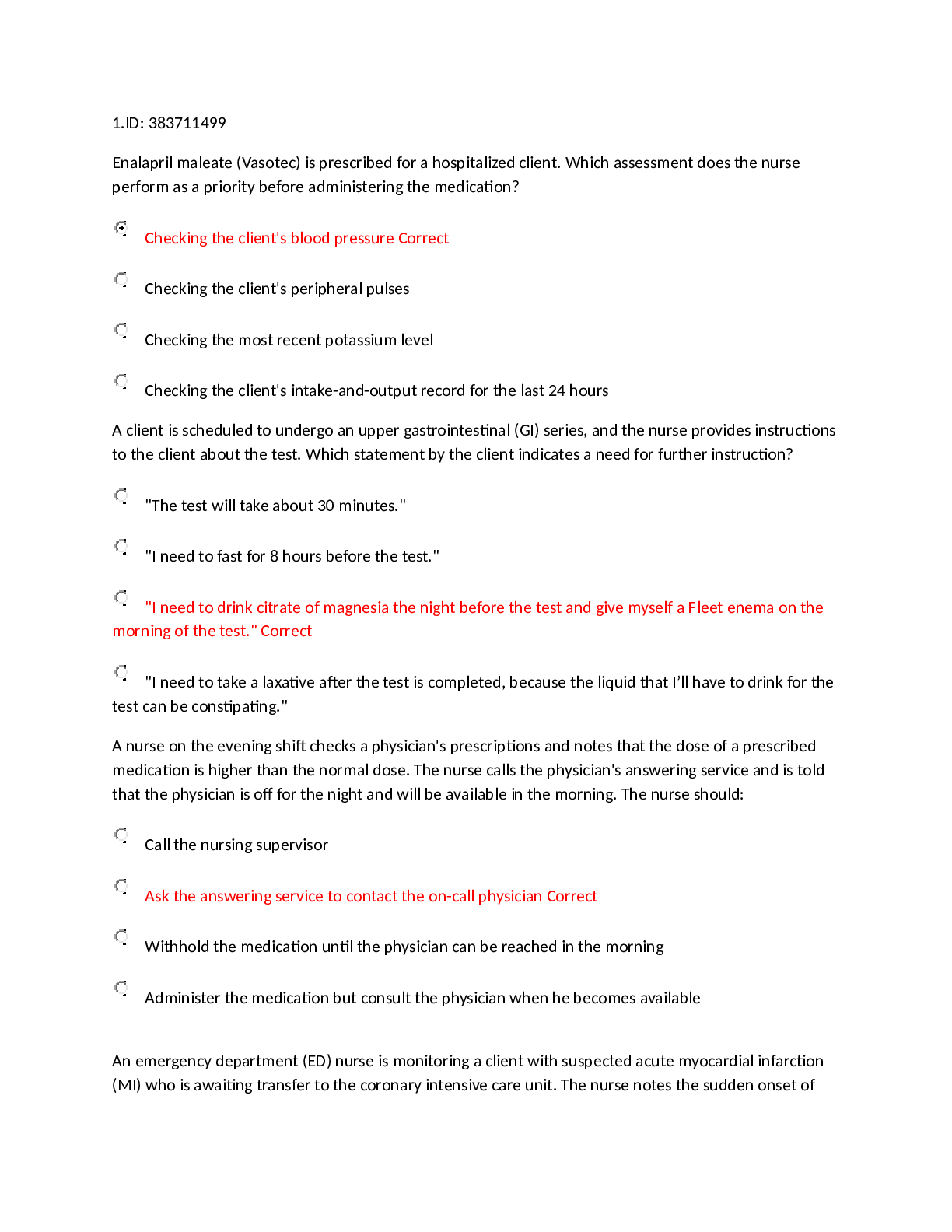




 (1).png)



